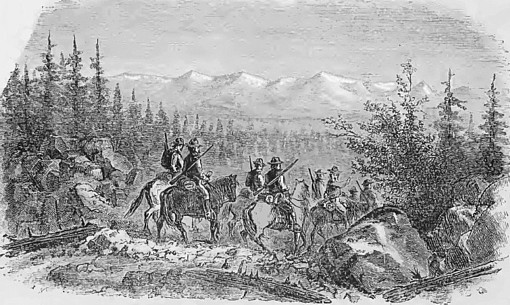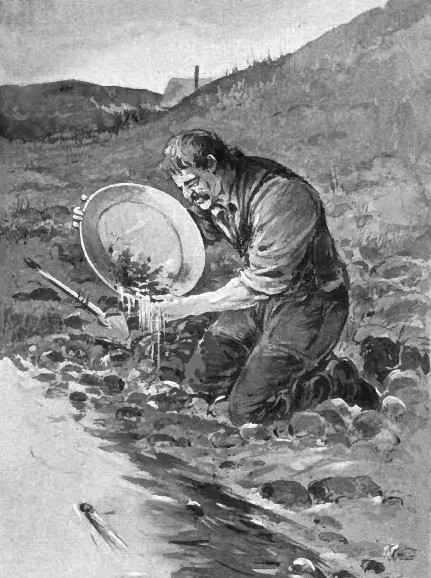Up in the northeastern corner of Union county, at an altitude of from 4,600 to 9,000 feet, among the Powder River mountains, is the Cornucopia district, with a mineral belt 6 miles long, by from 2 to 3 miles wide, on which ledges of gold ore running from $5 to $50 to the ton are exposed in more than 30 mines and prospects. The Union Companion has opened up 20 fissure veins by a 1,200- foot tunnel, has a stamp mill and concentrator run by electricity generated by waterpower, and a 6-ton chlorination plant. Its ore goes from $6 to $25 to the ton, of which about 80 per cent, is saved, part by battery and plate amalgamation, and the rest by concentration. The mine produces, with its present equipment, from $15,000 to $20,000 a month. The Red Jacket has milled several thousand tons of ore. A number of adjacent claims have shipped ore, running from $60 to $300 to the ton, to Puget Sound smelters, and the two small custom-mills of the camp are kept busy. The Simmons group shows several ledges of $15 ore. In Eagle Creek district, southwest of Cornucopia, the Cady mines are profitably running a 10 stamp mill, and have thousands of tons of ore in sight.
In the Sanger district, southwest of Eagle, the Bradley mine, formerly known, as the Sanger, has produced between $500,000 and $1,000,000, all above the 280-foot level. It has a l0 stamp mill, and has just added concentrating-works. The Basin, a new discovery, is working ore that goes from $10 to $60 to the ton, with a 5-stamp mill. The placer gold nugget diggings around Sparta have yielded many hundreds of thousands of dollars—some authorities say millions—but there are immense placer-beds yet unworked, and prospecting for quartz veins has just begun. Some rich finds have been made within the last month.
Starting westward from Baker City, the mineral beds begin almost in the municipal limits. Splendid quartz prospects have been recently found within two or three miles of the courthouse. A short distance southwest is Auburn Gulch, that has yielded millions of placer gold, and the Robinson and Carpenter placers are steadily producing the golden dust. The Elkhorn mountains, a spur of the great Blue range, are an almost unbroken series of ore-bodies.
The Tom Paine, near Pocahontas, eight miles west of Baker City, has turned out some of the richest quartz ever found in the region, running into thousands of dollars to the ton. Its ordinary milling ore yields about $30 to the ton. Sixteen miles northwest of Baker City are the Baisley-Elkhorn and Robbins-Elkhorn mines, both with vast ledges of gold ore opened up, running from $3 to $300 to the ton. The Maxwell is running a 10 stamp mill on $15 ore, of which it has an inexhaustible mass. The Beckwith has yielded thousands of dollars; the Barnes, Phillips and Irving are promising prospects; and the Chloride has a ledge from 30 to 40 feet wide, that runs $35 to the ton. It has a large vein of gold in granite, and another of silver ore in slate.
About 34 miles west of Baker City is the renowned Cracker Creek district, with Bourne as its post office town. The whole region is mineralized, timber and water are abundant, and every facility exists for cheap mining. The Eureka and Excelsior, under the management of the Messrs. Longmaid, as lessees, has become one of the most notable mines in Oregon. It has opened up, with a 1,200-foot tunnel, an ore-ledge from 20 to 200 feet wide. With a 20-stamp mill and concentrators, 70 tons of ore a day are handled at a total expense of $2.90 a ton.
The North Pole, adjoining the Eureka and Excelsior on the north, has a 10 stamp mill, a 10 ton furnace, and a cyanide process plant, with a capacity of 25 tons a day, and is reducing its own ore. which yields $16 to the ton, with enough in sight to run for years. Just south of the Eureka and Excelsior, the Columbia has a ledge from 30 to 70 feet wide, opened up for 250 feet. Part of its ore is rich in free gold, and specimens of its calaverite telluride ore have run from $100,000 to $300,000 to the ton—or about half pure gold. It has its own stamp-mill and concentrator. Good prospects have been found in the Appomattox, Golconda, Wide West, Amazon and Bunker Hill. Parallel with the Columbia on the west is the Ohio, which has just erected a l0 stamp mill on a body of ore that runs from $2 to $200 to the ton. Five miles southwest of Cracker Creek, the newly discovered Ibex has a ledge ranging from 10 to 40 feet wide. A carload of its ore recently netted over $200 to the ton. The Ball Mountain, north of the Ibex, has three chutes of the same ore as its neighbor. Northeast of the Ibex, the Mammoth yielded thousands of dollars of free gold with a 5-stamp mill; then the sulfides were struck, and it was practically abandoned—which is. in brief, the history of half the mines in Oregon. Now, with the improved methods of treatment, the Mammoth will doubtless speedily resume its
place among the rich producers. There is a wide territory here almost wholly unexplored, and prospectors will find it one of the most inviting fields in America. Cable Cove district, which lies six miles west of Cracker Creek, or Bourne, contains many large bodies of rich sulfides, that are only waiting for capital to put the necessary reduction-works on them, to make them bonanza mines. Shipments of ore from the California have yielded from $60 to $200 to the ton. The Imperial. Ivy May. Red Chief, Crown Point, Winchester. Mormon Hoy and Donnelly-Thornton have all struck good ore. The Baker City group has a ledge of free-gold quartz that runs as high as $200 to the ton, and a claim recently discovered by Harvard Ransom has shipped a carload of ore that yielded $58 to the ton in gold and silver ore.
Return
to The Oregon History Page:
Oregon Gold Rush History



